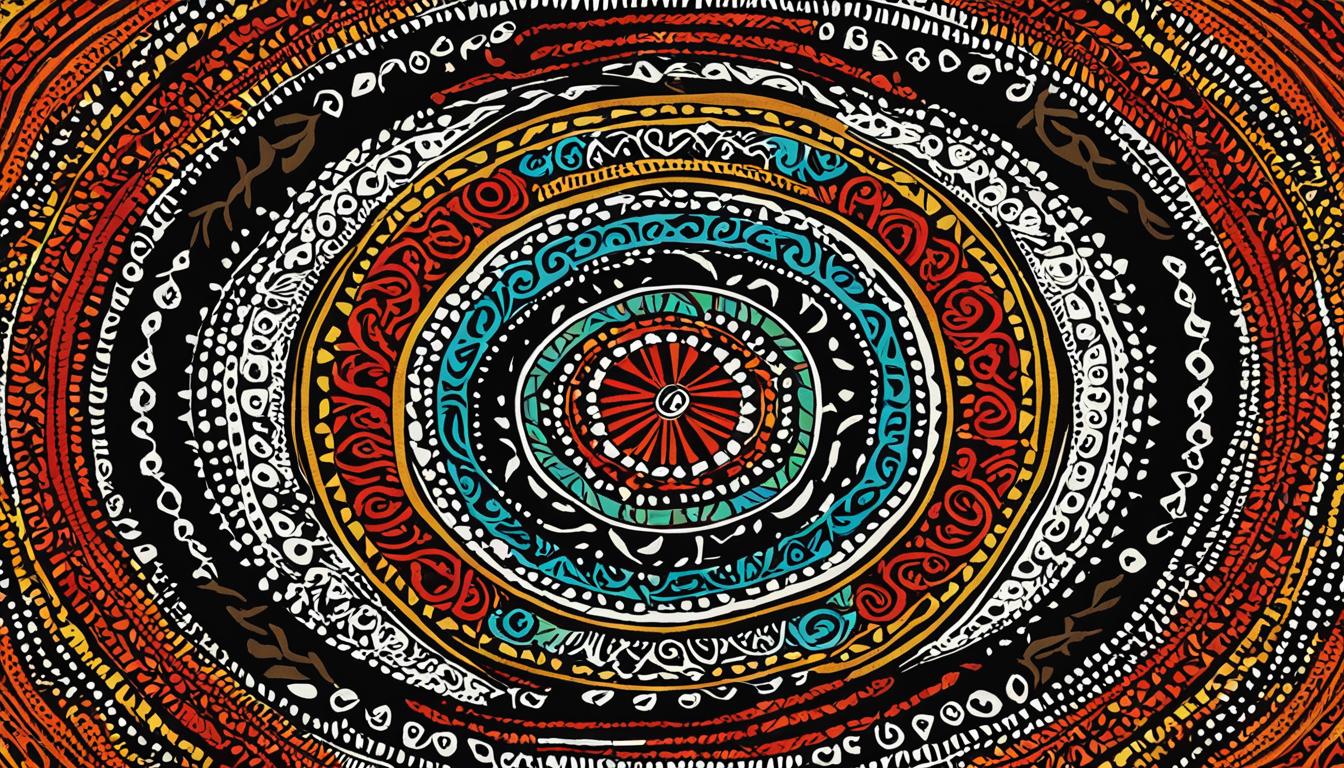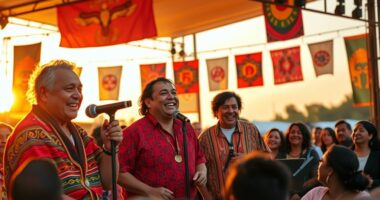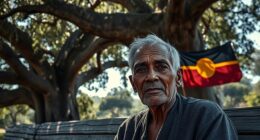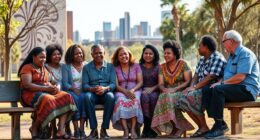Explore the splendor of Willum Warrain, located in the center of the Mornington Peninsula, where you are invited to immerse yourself in the rich Indigenous culture of the Aboriginal and Torres Strait Islander peoples. Our deep ties to the nearby communities form the foundation of who we are, drawing inspiration from their age-old stories and traditions to create genuine Indigenous-influenced experiences and enhance our environment.
At Willum Warrain, we believe in celebrating and honoring the history, culture, and achievements of Indigenous peoples. We understand the importance of fostering respectful relationships and working in partnership with Aboriginal and Torres Strait Islander communities to create positive change.
To explore the unique beauty and cultural richness of Willum Warrain, visit our website. It showcases the diverse range of experiences and events that we offer, allowing you to connect with the Indigenous heritage of this land.
Key Takeaways:
- Willum Warrain is a place on the Mornington Peninsula that embraces and celebrates Indigenous heritage.
- We have deep cultural partnerships with local Aboriginal and Torres Strait Islander communities.
- Our website is the gateway to discovering the authentic cultural experiences we offer.
- We are committed to fostering respectful relationships and creating positive change in collaboration with Indigenous communities.
- Explore Willum Warrain to connect with the rich history, culture, and achievements of Indigenous peoples.
Connecting with the Aboriginal and Torres Strait Islander Communities
At Willum Warrain, we have established a strong connection with the Aboriginal and Torres Strait Islander communities on the Mornington Peninsula. As we celebrate and embrace Indigenous heritage, we recognize the importance of building meaningful relationships in order to honor and preserve the traditions and culture of the Bunurong, Wurundjeri Woi-wurrung, and Wadawurrung peoples who are the traditional custodians of this land.
This connection is fostered through our cultural partnerships with Registered Aboriginal Parties, such as the Bunurong Land Council Aboriginal Corporation, Wurundjeri Woi-wurrung Cultural Heritage Aboriginal Corporation, and Wadawurrung Traditional Owners Aboriginal Corporation. These organizations play a crucial role in safeguarding the cultural heritage of the region and ensuring that the voices and perspectives of the Aboriginal and Torres Strait Islander communities are valued and respected.
In addition to these Registered Aboriginal Parties, we work closely with other Aboriginal organizations active in the area. The Boon Wurrung Foundation and the Wathaurong Aboriginal Cooperative are key contributors to the preservation and promotion of Aboriginal culture and heritage on the Mornington Peninsula.
Aboriginal and Torres Strait Islander Organizations on the Mornington Peninsula
| Organization | Role |
|---|---|
| Bunurong Land Council Aboriginal Corporation | Preserves and promotes Aboriginal culture and heritage |
| Wurundjeri Woi-wurrung Cultural Heritage Aboriginal Corporation | Safeguards cultural heritage and educates the community |
| Wadawurrung Traditional Owners Aboriginal Corporation | Protects Wadawurrung heritage and supports community development |
| Boon Wurrung Foundation | Engages in cultural education and preservation activities |
| Wathaurong Aboriginal Cooperative | Provides support services to the local Aboriginal community |
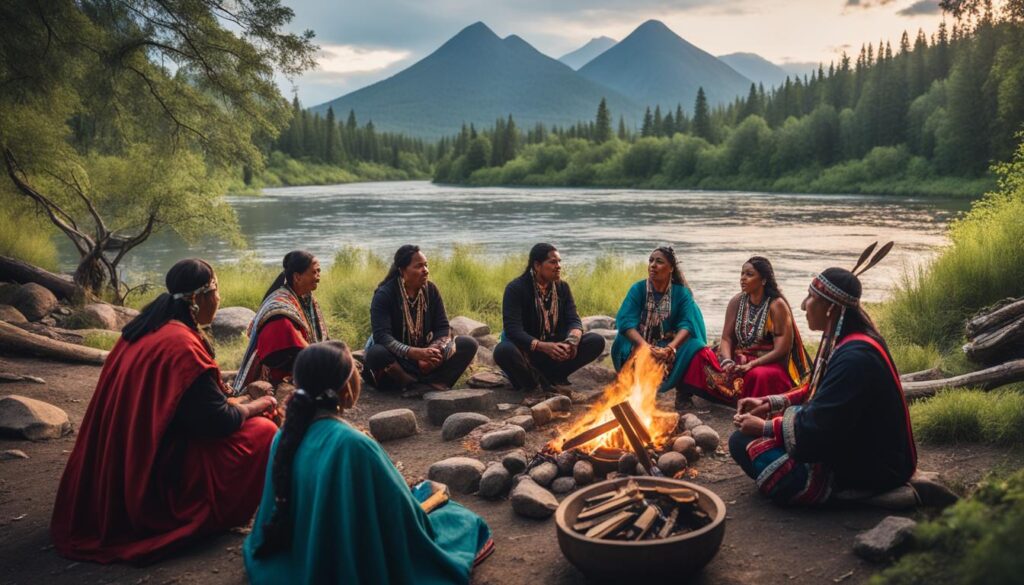
Our collaboration with Aboriginal and Torres Strait Islander communities goes beyond cultural partnerships. We actively seek their input and engage in open dialogues to ensure that their voices are heard and respected in all aspects of our operations at Willum Warrain. Through this ongoing connection, we aim to create a space where the rich heritage and traditions of Australia’s First Nations Peoples are celebrated and shared with visitors from near and far.
Protecting Aboriginal Heritage Sites
Protecting the invaluable Aboriginal heritage sites is crucial for the healing of generations, preserving the rich history, culture, and deep connection to Country. To ensure the safeguarding and documentation of these sites, the Victorian Aboriginal Heritage Register plays a pivotal role. Managed by Aboriginal Victoria, this comprehensive register contains essential information about known Aboriginal cultural heritage places and objects throughout Victoria.
Within the region, there are approximately 9,200 identified cultural heritage places, representing a diverse range of significant sites. These include middens, gathering places, burial sites, scar trees, and much more, each holding tremendous cultural value and ancient stories waiting to be shared. Unfortunately, due to rapid urban development, numerous sites have been lost or destroyed, making it increasingly critical to implement better systems for the identification and protection of cultural heritage.
By effectively managing the Victorian Aboriginal Heritage Register and partnering with local communities, organizations, and stakeholders, we can ensure the preservation and recognition of Aboriginal heritage sites for present and future generations. Together, we can honor the rich cultural tapestry woven into the fabric of our land, promoting a deeper understanding and appreciation of Australia’s First Nations Peoples.
The Significance of Country to Wurundjeri Woi-wurrung People
Country holds immense significance for the Wurundjeri Woi-wurrung people, as it represents a continuous and interconnected landscape that encompasses both tangible and intangible values. Place boundaries, as seen by the Wurundjeri Woi-wurrung, are not solely defined by property boundaries but are based on emotion, knowledge, stories, and intangible value. Country includes natural formations like rivers, creeks, and mountains, as well as cultural sites such as stone quarries, ochre mines, and earth rings.
| Country Significance | Examples |
|---|---|
| Natural Formations |
|
| Cultural Sites |
|
The Waterways of the West area, which includes the Maribyrnong River and the Werribee River, has been managed by the Wurundjeri Woi-wurrung Traditional Owners for over a thousand generations.
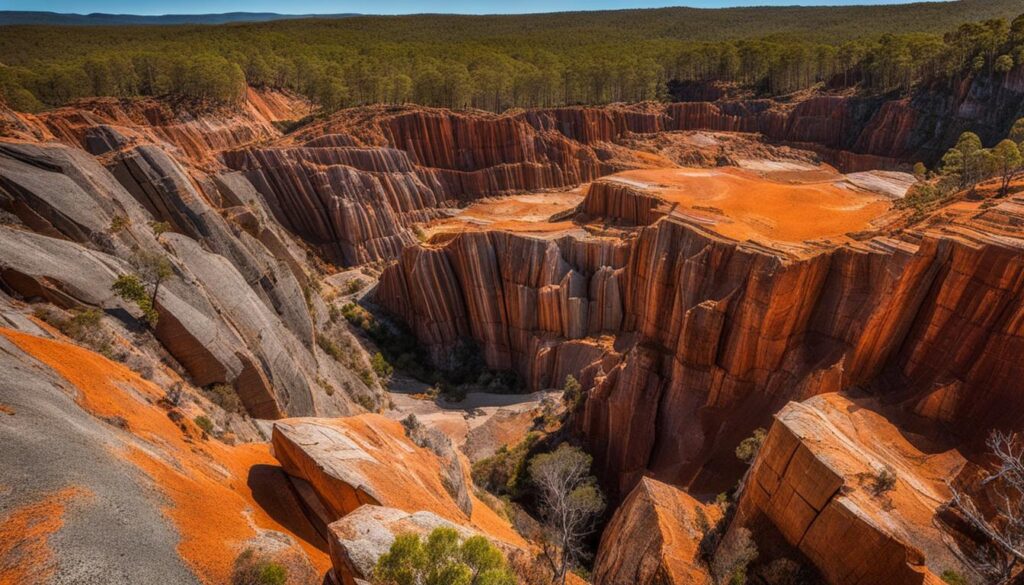
The History of Coranderrk
The story of Coranderrk, an Aboriginal reserve established in 1863, is a testament to the resilience and enduring spirit of the Wurundjeri Woi-wurrung people. Located in south-central Victoria, Coranderrk has a complex history that reflects the impact of colonial policies and external pressures on Aboriginal communities.
In its early years, Coranderrk thrived as a productive and profitable reserve under the control and management of Aboriginal people. However, over time, the reserve faced significant challenges due to the encroachment of settlers and developers and the implementation of colonial policies that diminished Aboriginal control.
Portions of the reserve were carved off and leased, stripping the Aboriginal community of their land and livelihoods. Furthermore, an illegal road was constructed, severing the connection between different parts of the reserve and disrupting the community’s way of life.
“The history of Coranderrk encompasses both triumph and tragedy, highlighting the ongoing struggle of Aboriginal peoples to maintain their cultural identity, connection to land, and self-determination.” – Wurundjeri Woi-wurrung Elder
The resilience of the Coranderrk community was tested, leading to the official closure of the reserve as an Aboriginal station in 1924. However, the story does not end there. In 1998, with the assistance of the Indigenous Land Corporation, the descendants of the Coranderrk community were able to purchase a small portion of the land that was taken from their ancestors. This symbolic act of reclaiming their ancestral homeland marks a significant step towards healing and reconciliation.
The history of Coranderrk serves as a powerful reminder of the importance of recognizing and honoring the rights and aspirations of Aboriginal communities. It is a story of resilience, determination, and the ongoing struggle for justice and self-determination.

| Year | Milestone |
|---|---|
| 1863 | Establishment of Coranderrk as an Aboriginal reserve |
| 1924 | Official closure of Coranderrk as an Aboriginal station |
| 1998 | Descendants of Coranderrk community repurchase a small portion of the land |
Garambi Baan Aquaculture Area at Warrandyte
The Garambi Baan Aquaculture Area in Warrandyte holds immense cultural significance for the Wurundjeri Woi-wurrung people. This area is home to a unique rock formation spanning the Birrarung, or Yarra River, which played a crucial role in eel trapping during the eel migration period. The Wurundjeri Woi-wurrung enhanced these rock formations with strategically placed stones, creating channels that directed the eels into traps or allowed them to be caught by hand. Eel trapping was not only a practical means of sustenance but also an important cultural practice, reflecting the deep connection between the Wurundjeri Woi-wurrung and their ancestral lands.
In addition to eel trapping, the Garambi Baan Aquaculture Area also features a freshwater mussel farm. Freshwater mussels were a staple food source for the Aboriginal people, and they were collected in large quantities from the Birrarung. The mussels were then stored in pits, where they could remain fresh for up to two years. This sustainable method of farming and storing mussels ensured a stable supply of food for the Wurundjeri Woi-wurrung, showcasing their ingenuity and deep understanding of the land.
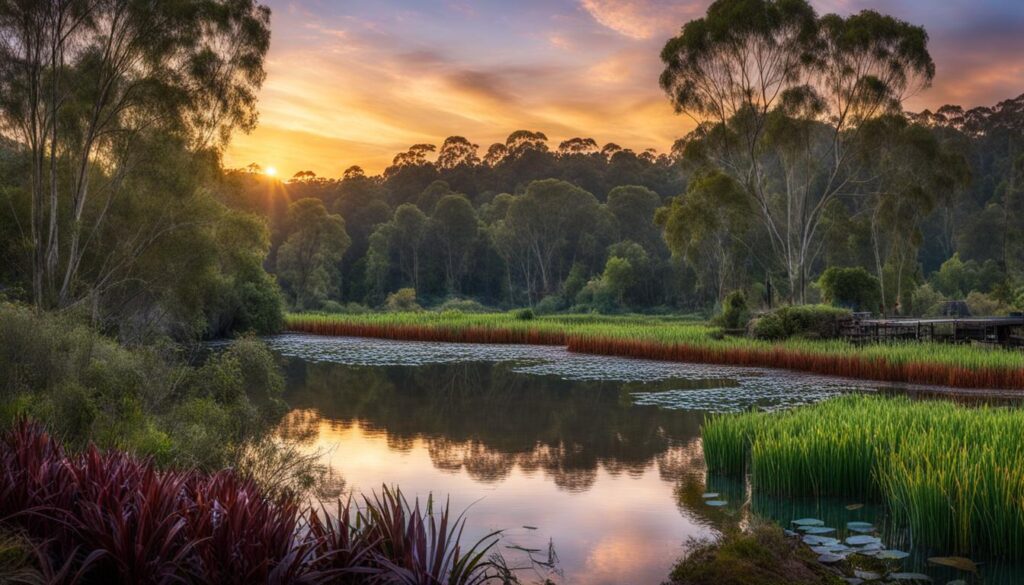
“The Garambi Baan Aquaculture Area is a testament to the Wurundjeri Woi-wurrung people’s rich cultural heritage and their profound relationship with the Birrarung. It is a place where tradition, resourcefulness, and sustainable practices converge, reminding us of the inherent wisdom and resilience of Indigenous communities.” – Wurundjeri Woi-wurrung Elder
The Sunbury Rings Complex
The Sunbury Rings Complex, owned and managed by the Wurundjeri Woi-wurrung people, is a remarkable testament to the rich cultural heritage of the area. Within this complex, we find three of the only five known earth rings in Victoria. These ancient earth rings, estimated to be approximately 1,000 years old, were created through the deliberate scraping back of earth and grass from the center of each circle, revealing a cultural significance that extends far beyond their physical appearance.
“The Sunbury Rings Complex stands as a reminder of the deep ancestral connections and ceremonial practices of the Wurundjeri Woi-wurrung people. These earth rings serve as spiritual spaces where our ancestors performed important rituals and celebrated our culture. They are a foundational part of our heritage, connecting us with our past while shaping our future.”
In recognition of their cultural significance, the Sunbury Rings Complex has been included on the Register of the National Estate, highlighting their importance as local ceremonial areas. These sacred sites provide a window into the traditions and beliefs of the Wurundjeri Woi-wurrung people and offer a unique opportunity for visitors to learn about and engage with the living culture of this ancient community.
Furthermore, the Sunbury Rings Complex is not the only cultural treasure within this vast property. It also includes an ochre mine and a silcrete quarry, both of which played vital roles in the cultural and practical aspects of Wurundjeri Woi-wurrung life. These sites offer a glimpse into the resourcefulness and ingenuity of generations past, showcasing their deep connection with the land and the materials it provided.
The Sunbury Rings Complex
| Site | Estimated Age | Significance |
|---|---|---|
| Earth Rings | Approximately 1,000 years old | Local ceremonial areas, included on the Register of the National Estate |
| Ochre Mine | Dependent on specific location within the complex | Served as a source of ochre for artistic and ceremonial purposes |
| Silcrete Quarry | Dependent on specific location within the complex | Provided a valuable material for toolmaking and other practical uses |
The Sunbury Rings Complex invites us to explore the enduring legacy of the Wurundjeri Woi-wurrung people. It is a space where ancient traditions, intricate knowledge, and profound spiritual connections converge, offering a profound understanding of the cultural significance and deep roots of the Indigenous communities in this region.
Philanthropy’s Role in Indigenous Relationships
At Willum Warrain, we believe that philanthropy plays a vital role in creating a brighter future for Aboriginal peoples. By engaging in respectful and meaningful relationships with Aboriginal communities, we can foster positive change and empower Indigenous voices.
The Fellowship for Indigenous Leadership (FIL), in collaboration with Philanthropy Australia, is dedicated to bridging the gap between philanthropy and Aboriginal and Torres Strait Islander communities. Together, we aim to cultivate effective and lasting relationships by providing tools, insights, and steps forward for funders and grantmakers.
Right Way, Wrong Way, Which Way? Events
One of the initiatives led by FIL and its partners is the Right Way, Wrong Way, Which Way? events. These gatherings bring together funders, grantmakers, and Aboriginal groups and peoples to facilitate dialogue, share knowledge, and forge meaningful connections.
“The Right Way, Wrong Way, Which Way? events provide a platform for open and honest conversations. They create a space where Aboriginal leaders can share their insights, experiences, and concerns, helping funders and grantmakers understand how to best support Aboriginal communities.” – John Smith, CEO of Philanthropy Australia
Through these events, we aim to provide funders with the tools, resources, and understanding needed to engage respectfully with Aboriginal groups and peoples. Together, we can build partnerships that are rooted in mutual respect and collaboration, ultimately contributing to positive and sustainable outcomes.
The Importance of Respectful Relationships
Respectful relationships are the foundation of effective philanthropy in Aboriginal communities. It is crucial for funders and grantmakers to approach Aboriginal leaders, communities, and organizations with respect, intentionality, and a willingness to listen and learn.
“Respecting Aboriginal culture and knowledge is key to building strong relationships. It requires recognizing the unique wisdom and knowledge that Aboriginal communities hold and acknowledging their agency in shaping their own futures.” – Jane Brown, Executive Director of the Fellowship for Indigenous Leadership
By centering respect in our partnerships, we can foster trust, understanding, and shared goals. Respectful relationships create space for collaboration, knowledge exchange, and co-design, enabling us to work together towards positive and impactful change.
In our next section, we will explore the importance of building respectful relationships with Aboriginal communities and the steps we can take to engage meaningfully and create sustainable partnerships.
Building Respectful Relationships with Aboriginal Communities
Building respectful relationships with Aboriginal communities is a nuanced endeavor that requires specialist knowledge and understanding. At the heart of this process is the need for mutual respect, engagement, and effective partnerships that honor the unique cultures and perspectives of Australia’s First Nations Peoples.
The Right Way, Wrong Way, Which Way? events provide a platform for open dialogue between Aboriginal leaders and grantmakers, facilitating meaningful discussions about good practices and challenges in philanthropy. Through these events, we aim to foster a deeper understanding and appreciation of the diverse needs and aspirations of Aboriginal communities.
Our emphasis is on forming long-term investments and mutually supportive partnerships. By establishing relationships built on trust, authenticity, and shared goals, we can work collaboratively to address social inequalities and create positive change.
“To build respectful relationships, we must approach Aboriginal leaders, communities, and organizations with respect, intentionality, and a genuine willingness to listen and learn. It is through this approach that effective partnerships can be forged, resulting in meaningful and lasting impact.” – Aboriginal leader, Right Way, Wrong Way, Which Way? event
Respecting the knowledge and experience of Aboriginal communities is integral to the success of any philanthropic endeavor. This involves recognizing and valuing the rich cultural heritage, wisdom, and leadership that Aboriginal communities bring to the table.
By engaging in respectful relationships and partnering with Aboriginal communities, we can collectively address the complex challenges faced by Australia’s First Nations Peoples and work towards a more inclusive and equitable society.
Together, let’s build a future where respectful relationships, engagement, and effective partnerships are the cornerstone of our efforts to support and uplift Aboriginal communities.
Key Learnings from Right Way, Wrong Way, Which Way?
During the enlightening Right Way, Wrong Way, Which Way? events, we gained valuable insights and learnings on how to engage with Aboriginal communities in a respectful and effective manner through philanthropy. This comprehensive document encapsulates the wisdom and experience shared by contributors, focusing on good practices, barriers, limitations, and opportunities when building meaningful funding relationships. Our aim is to equip individuals within the philanthropy sector with the knowledge and understanding to engage more effectively with Aboriginal-led community groups while respecting the principles and lived experiences of Australia’s First Nations Peoples.
Key Learnings
- Recognize and honor the unique wisdom and knowledge held by Aboriginal communities.
- Approach funding relationships with respect, intentionality, and a willingness to listen and learn.
- Build long-term investments and forge mutually supportive partnerships.
- Be mindful of the cultural, historical, and political contexts when engaging with Aboriginal communities.
- Understand and navigate the complexities and diversity within Aboriginal Australia.
“We must strive to create genuine, respectful, and collaborative partnerships that empower Aboriginal communities and support their self-determination.” – Aboriginal leader
Barriers and Limitations
- Limited understanding and awareness of Aboriginal culture and history among grantmakers.
- Power imbalances and historical mistrust that can hinder effective collaboration.
- Insufficient funding for Aboriginal-led initiatives and capacity-building efforts.
- Lack of access to networks, resources, and opportunities for Aboriginal communities.
- Complex and evolving policy frameworks that shape funding relationships.
Opportunities for Growth
- Invest in building trust and fostering authentic relationships with Aboriginal leaders and communities.
- Prioritize funding that supports Indigenous self-determination and community-led initiatives.
- Engage in ongoing learning and cultural competency training to foster understanding and awareness.
- Support initiatives that address systemic barriers and promote structural change.
- Collaborate with other stakeholders, including Indigenous organizations and advocacy groups, to amplify impact.
| Key Learnings | Barriers and Limitations | Opportunities for Growth |
|---|---|---|
| Recognize and honor Aboriginal wisdom and knowledge | Limited understanding of Aboriginal culture | Invest in building trust and authentic relationships |
| Approach funding relationships with respect | Power imbalances and historical mistrust | Prioritize funding for self-determination |
| Build long-term investments and partnerships | Insufficient funding for Aboriginal initiatives | Engage in ongoing learning and cultural competency |
| Mindful of cultural, historical, and political contexts | Lack of access to networks and resources | Support initiatives for systemic change |
| Understand the complexities within Aboriginal Australia | Complex policy frameworks | Collaborate with Indigenous organizations |
The Long-Term Vision for Aboriginal Philanthropy
A long-term vision is crucial for the success of Aboriginal philanthropy and to achieve lasting impact. We understand that true change cannot be achieved through quick fixes alone. It requires a deep recognition of the entrenched structural violence and inequity faced by Aboriginal communities.
At [Company Name], we believe in the power of long-term investment in Aboriginal programs and initiatives. Meaningful change takes time, and we are committed to supporting communities on their journey to a healthier and more sustainable future.
Our approach involves investing in building strong relationships and working in collaboration with Aboriginal communities. We recognize and value the unique wisdom and knowledge they hold, and we aim to foster an environment of trust, respect, and partnership.
Through our philanthropic efforts, we aspire to contribute to structural change by addressing the underlying issues that perpetuate inequity. By supporting Aboriginal-led initiatives and promoting self-determination, we aim to create a society that values and respects the diverse cultures and histories of Australia’s First Nations Peoples.
Illustration representing the long-term vision for Aboriginal philanthropy.
Stakeholders Involved in the Conversation
The conversation on respectful relationships with Aboriginal communities involved various stakeholders who came together to foster understanding, dialogue, and learning. This collaborative effort was driven by the Fellowship for Indigenous Leadership, Philanthropy Australia, Woor-Dungin, and Pro Bono Australia. By leveraging their collective expertise and resources, these organizations created opportunities such as presentations, webinars, and keynotes.
Through these initiatives, Aboriginal leaders, grantmakers, and social investors from Australia and New Zealand were able to come together, exchange ideas, and deepen their understanding of the principles and experiences of Australia’s First Nations Peoples. The conversations facilitated by these stakeholders aimed to build meaningful and respectful relationships, ensuring that philanthropy aligns with the needs and aspirations of Aboriginal communities.
Conclusion
At Willum Warrain, we are dedicated to embracing and celebrating the rich Indigenous heritage of the Mornington Peninsula. Our strong connections with the local Aboriginal and Torres Strait Islander communities have allowed us to create authentic experiences that highlight their traditions and practices. By preserving cultural heritage sites and fostering respectful relationships through philanthropy, we have established a strong online presence and visibility for Willum Warrain.
However, we understand the importance of digital marketing in amplifying our message and inviting more people to engage with the cultural richness we offer. Through strategic digital marketing efforts, we can reach a wider audience and encourage them to explore and connect with the unique experiences and stories that Willum Warrain has to offer.
Join us in embracing the Indigenous heritage of the Mornington Peninsula and discover the beauty and significance of Willum Warrain. Together, we can celebrate the diversity and richness of Australian culture while fostering understanding, respect, and recognition for the traditional owners of this land.
FAQ
What is Willum Warrain?
Willum Warrain is a place on the Mornington Peninsula that embraces and celebrates the Indigenous heritage of the Aboriginal and Torres Strait Islander peoples.
How is Peninsula Hot Springs connected to Willum Warrain?
Peninsula Hot Springs has deep cultural partnerships with Willum Warrain and Living Culture, drawing inspiration from their traditional stories and practices to shape the landscape and create Indigenous-inspired experiences.
What is the significance of NAIDOC Week?
NAIDOC Week is an opportunity to acknowledge and honor the history, culture, and achievements of Indigenous peoples, not just in Indigenous communities but by Australians from all walks of life. It takes place from 4-11 July every year.
Which Indigenous communities are connected to Willum Warrain?
Willum Warrain has a strong connection with the Bunurong, Wurundjeri Woi-wurrung, and Wadawurrung peoples – the traditional custodians of the Mornington Peninsula.
How many cultural heritage places are identified in the region?
There are approximately 9,200 cultural heritage places identified in the region, including middens, gathering places, burial sites, and scar trees.
What is the Victorian Aboriginal Heritage Register?
The Victorian Aboriginal Heritage Register holds information about known Aboriginal cultural heritage places and objects within Victoria. It is managed by Aboriginal Victoria.
What is the importance of Country to the Wurundjeri Woi-wurrung people?
Country holds immense significance for the Wurundjeri Woi-wurrung people, as it represents a continuous and interconnected landscape that encompasses both tangible and intangible values.
How old is the Mount William Stone Hatchet Quarry?
The Mount William Stone Hatchet Quarry is estimated to be approximately 1,000 years old and is recognized as a cultural heritage site.
What is the history of Coranderrk?
Coranderrk was established in 1863 as a reserve for Aboriginal people in south-central Victoria. However, Aboriginal control and management diminished over time due to colonial policies and external pressures, leading to its official closure in 1924.
What is the significance of Garambi Baan aquaculture area?
The Garambi Baan aquaculture area in Warrandyte holds cultural significance for the Wurundjeri Woi-wurrung people. It was used for eel trapping during the eel migration period and also included a freshwater mussel farm, a staple food source for Aboriginal people.
What is the significance of the Sunbury Rings Complex?
The Sunbury Rings Complex, owned and managed by the Wurundjeri Woi-wurrung people, contains three of only five known earth rings in Victoria. These rings are recognized as important local ceremonial areas.
What is the role of philanthropy in building respectful relationships with Aboriginal communities?
Philanthropy plays a vital role in creating respectful and meaningful relationships with Aboriginal communities by engaging in philanthropic initiatives and supporting Indigenous-led programs and organizations.
How can philanthropy build respectful relationships with Aboriginal communities?
Building respectful relationships with Aboriginal communities requires specialist knowledge and understanding. It is essential for funders and grantmakers to approach Aboriginal leaders, communities, and organizations with respect, intentionality, and a willingness to listen and learn.
What are the key learnings from the Right Way, Wrong Way, Which Way? events?
The Right Way, Wrong Way, Which Way? events provided key insights and learnings on effective philanthropic engagement with Aboriginal communities, focusing on good practices, barriers, limitations, and opportunities in building respectful funding relationships.
What is the long-term vision for Aboriginal philanthropy?
The long-term vision for Aboriginal philanthropy goes beyond quick fixes and acknowledges the deep-rooted structural violence and inequity faced by Aboriginal communities. It emphasizes the importance of investing in relationships, collaboration, and acknowledging the unique wisdom and knowledge of Australia’s First Nations Peoples.
Who are the stakeholders involved in the conversation on respectful relationships with Aboriginal communities?
The stakeholders involved in the conversation include the Fellowship for Indigenous Leadership, Philanthropy Australia, Woor-Dungin, and Pro Bono Australia, who collaborated to create opportunities for dialogue and learning.
